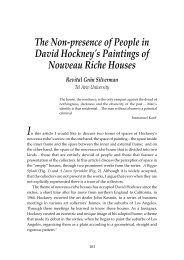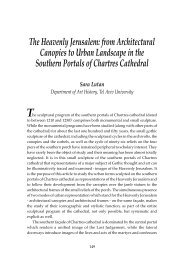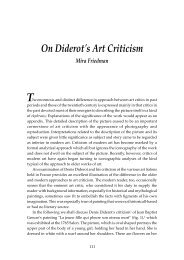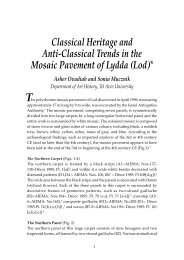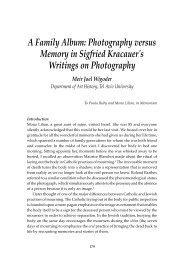Tumarkin's Homage to the Pietà Rondanini Avigdor WG Posèq
Tumarkin's Homage to the Pietà Rondanini Avigdor WG Posèq
Tumarkin's Homage to the Pietà Rondanini Avigdor WG Posèq
Create successful ePaper yourself
Turn your PDF publications into a flip-book with our unique Google optimized e-Paper software.
any fur<strong>the</strong>r <strong>to</strong>uch would have been redundant and even detrimental <strong>to</strong> its<br />
perfection - but <strong>the</strong> very plenitude of Michelangelo’s message also represents<br />
<strong>the</strong> end of carving in marble as an artistic medium”. Elsewhere in his book<br />
Tumarkin praises primitive artists, especially African sculp<strong>to</strong>rs who, free from<br />
Western conventions and using divergent techniques, created superb works<br />
that brea<strong>the</strong>d new life in<strong>to</strong> modern art. 10 He admires especially <strong>the</strong> African<br />
sculp<strong>to</strong>rs’ skillful use of simple materials, and says of himself that he <strong>to</strong>o<br />
endeavours <strong>to</strong> create something new by composing everyday functional<br />
implements in a new context. This may be exemplified in <strong>the</strong> real troley and<br />
railway track which he added <strong>to</strong> his <strong>Pietà</strong>. The essentially non-mimetic aspect<br />
of this assemblage may thus be seen as its author’s deliberate reaction <strong>to</strong> <strong>the</strong><br />
concept of sculpture as an imitative art which, he feels, exhausted itself in<br />
Michelangelo’s last work. This concept of <strong>the</strong> <strong>Pietà</strong> <strong>Rondanini</strong>, as final expression<br />
of a venerable tradition, only sharpened Tumarkin’s attention of <strong>the</strong> emotional<br />
content of this statue.<br />
The special meaning of Michelangelo’s configuration has been widely<br />
discussed by art his<strong>to</strong>rians, with particular emphasis on <strong>the</strong> departure from<br />
<strong>the</strong> conventional formulas of <strong>the</strong> "Lamentation of Christ", which show Christ’s<br />
body ei<strong>the</strong>r prostrate on <strong>the</strong> ground or held on Mary’s lap, as in <strong>the</strong> Bella <strong>Pietà</strong><br />
Michelangelo’s earliest version of <strong>the</strong> subject. 11 The innova<strong>to</strong>ry concept of <strong>the</strong><br />
dead Christ standing vertically and seemingly absorbed in<strong>to</strong> his mo<strong>the</strong>r’s body<br />
has also attracted <strong>the</strong> attention of psychoanalysts, who have approached <strong>the</strong><br />
<strong>Pietà</strong> <strong>Rondanini</strong> against <strong>the</strong> background of Michelangelo’s childhood<br />
experiences, stressing <strong>the</strong> traumatic loss of his mo<strong>the</strong>r and lack of warmth in<br />
his relations with his fa<strong>the</strong>r, which in maturity resulted in a subconscious search<br />
for surrogate parent figures. 12 Michelangelo’s various representations of <strong>the</strong><br />
Madonna and Child, and also <strong>the</strong> early <strong>Pietà</strong> have been interpreted as a<br />
projection of his neurotic longing for mo<strong>the</strong>r love, while <strong>the</strong> <strong>Pietà</strong> <strong>Rondanini</strong><br />
has accordingly been unders<strong>to</strong>od as a symbolic expression of Michelangelo’s<br />
wish <strong>to</strong> be reunited with his mo<strong>the</strong>r, coinciding with <strong>the</strong> conscious awareness<br />
that <strong>the</strong> realization of this wish was possible only in death. 13<br />
Psychological insights are sometimes compared <strong>to</strong> artistic intuition and this<br />
may be especially true of <strong>the</strong> creative individual’s instinctive comprehension<br />
of <strong>the</strong> latent content of <strong>the</strong> work of ano<strong>the</strong>r artist. 14 Tumarkin’s spontaneous<br />
perception of <strong>the</strong> special personal meaning of Michelangelo’s last work as a<br />
<strong>to</strong>ken of his coming <strong>to</strong> terms with his life-long problems, was probably<br />
facilitated by certain analogies in his own childhood experiences which, like<br />
Michelangelo, he constantly exorcises in his art. 15 He was born in 1933 <strong>to</strong> a<br />
German fa<strong>the</strong>r and a Jewish mo<strong>the</strong>r who, submitting <strong>to</strong> racial laws, divorced<br />
197



